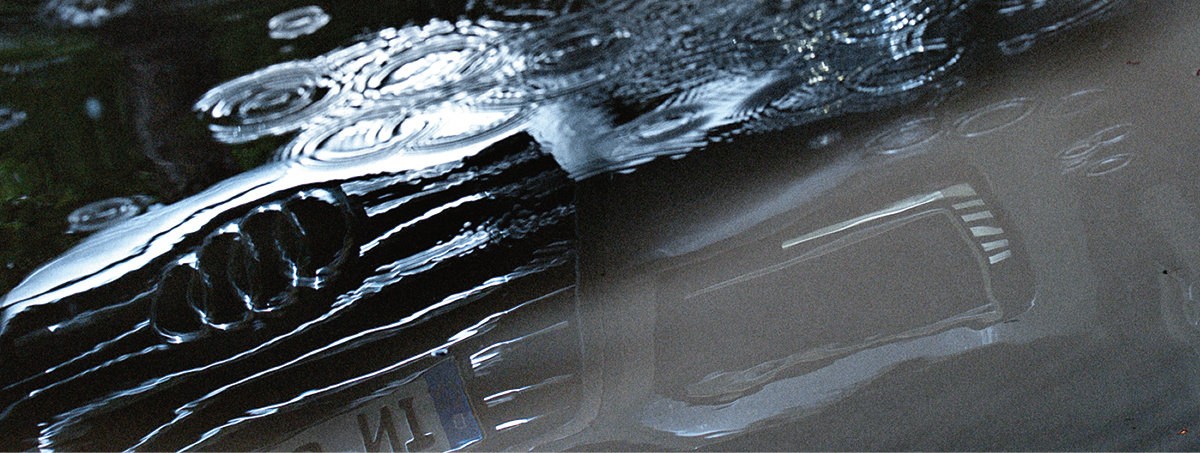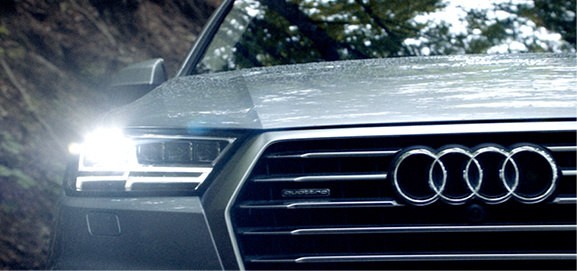
Sound of Nature
The Audi Q7 e-tron quattro combines the benefits of electric driving with the creature comforts of an SUV thanks to plug-in hybrid technology.
Hermann J. Müller (copy) & Loris Savino, Karim Bartoletti (photo)Unlike city life, nature seems peaceful—virtually silent. Its hushed sounds can only be heard when you pause briefly. The rustling of leaves by the tree, for instance: This soothing sound can reach anywhere between 10 and 20 decibels. Comparable with a whisper.
Wind is an exciting phenomenon. When wind meets a solid object, such as a tree, and is forced to go around it, that creates a vortex. Much like a swirl in water. Within such a vortex the air expands slightly, air pressure decreases and the expansion of the air triggers an impulse. When a number of these impulses reach our ears, we perceive the wind to be howling. We hear the wind but cannot see it. We see its effects, trees swaying, ripples on the water. With electric cars, the exact opposite is the case: You’re moving, and yet you hear next to nothing. No sonorous hum, no subtle purr of pistons going up and down in cylinders.


In the Audi Q7 e-tron 3.0 TDI quattro, the world’s first plug-in hybrid SUV with TDI and quattro drive, you notice it right when you press the ignition. That has less to do with the typically elaborate noise insulation in an Audi and more to do with the high-performance, high-voltage battery that makes the Audi Q7 an e-tron quattro. Push the ignition and at first all you hear is … nothing. With every cold start, as far as the battery charge level allows, the system automatically selects EV (which stands for electric vehicle). If you stay in that mode, the Audi Q7 e-tron quattro will take you up to 56 kilometers in pure electric mode—marking a new best for plug-in hybrid vehicles. It’s all made possible by the 168 battery cells in a liquid-cooled lithium-ion block mounted beneath the trunk that push out 17.3 kWh of power. Yet despite all those battery cells, the luggage compartment volume of max. 1,835 liters is still unparalleled in a direct comparison with the competition.
There are other ways of seeing it: Nature has multilayered facets of sound. The rush of a mountain stream can measure up to 70 decibels. And incidentally, sounds travels four times faster under water than in the air.
It’s up to the driver which mode—EV, hybrid or battery hold—he tells the system to use. In “hybrid” mode, the control electronics automatically regulate the interplay between the 190 kW six-cylinder TDI unit and the 94 kW electric motor to achieve maximum efficiency. Once a destination is fed into the navigation system, the ideal operating strategy—electric, hybrid or combustion—is automatically calculated and precisely tailored to the route.—also after the adaptive cruise control (ACC) has been activated. The SUV then accelerates up to the preselected speed and maintains it. But that’s not all. In countries with the requisite density of navigation data, the car’s predictive efficiency assistant allows it to automatically slow down within system limits in antici-pation of a speed limit, a gradient or a tight bend, to then accelerate again once the particular situation has passed. Visual feedback is provided by the MMI display’s energy flow reading or the power meter or rev counter on the Audi virtual cockpit that comes as standard. This tells the driver at any given moment whether just the TDI engine or just the electric motor—or both—are propelling the SUV.

Charging process: After hooking up to a public charging station or industrial power socket (7.2 kW maximum charge power), the range of up to 56 kilometers in pure electric mode will be available again in around 2.5 hours.


Audi Q7 e-tron 3.0 TDI quattro
| Engine | V6 cylinder TDI |
| Displacement | 2.967 cm3 |
| Power | 275 kW system output |
| Maximum torque | 700 nm system output |
| Transmission | 8-speed tiptronic |
| Acceleration 0–100 kph | 6.2 sec. in hybrid mode |
| Acceleration 0–60 kph | 6.5 sec. in electric mode |
| Electric reach | up to 56 km (NEDC) |

The active accelerator gives the driver haptic feedback. When the car is driving in electric mode, the first pressure point signals—depending on the battery charge level—when the TDI engine would be activated. If the accelerator is depressed beyond a second pressure point, this triggers the boost function where both TDI engine and electric motor feed the SUV’s full system power of 275 kW to the eight-speed tiptronic transmission. At that point, the subtle murmur of the engine can actually be heard inside the passenger compartment. And all it takes to accelerate the Audi Q7 e-tron quattro up to 100 km/h is 6.2 seconds. Once the driver then eases off the accelerator, the engine speed drops to idle running on the flat, the vehicle harnesses the existing momentum in sailing mode and more or less coasts along. Given an anticipatory style of driving, the Audi Q7 e-tron quattro slows down also using the electric motor, which acts as a generator on the overrun, feeding recuperated energy back to the battery. After all, the SUV is capable of a top speed of up to 230 km/h. And before you know it, physics has once more control of what you hear inside the car.
Audi Q7 e-tron 3.0 TDI quattro fuel consumption combined (in l/100 km): 1.9–1.8. CO2 emissions combined (in g/km): 50–48. Power consumption combined (in kWh/100 km): 19.0–18.1. Where stated in ranges, fuel consumption, CO2 emissions and efficiency classes depend on tires/wheels used.